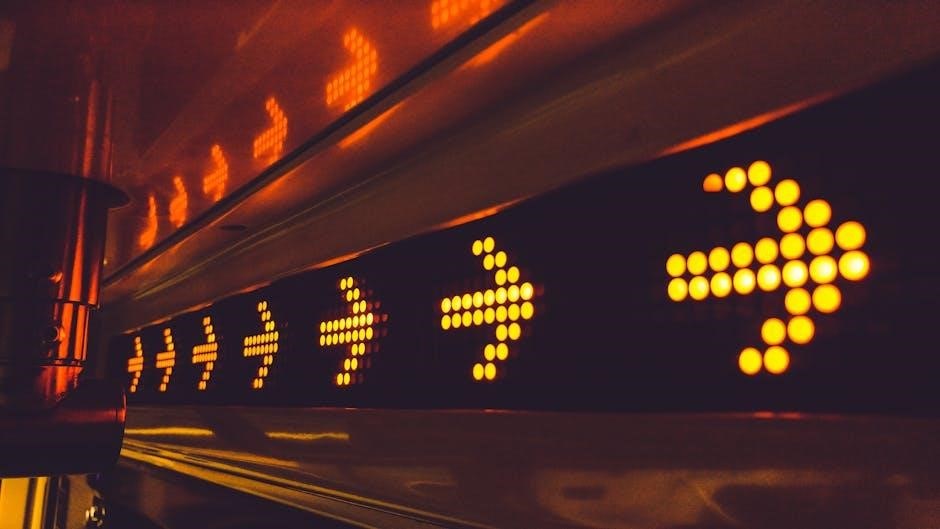This comprehensive guide provides detailed instructions for performing a K20 or K24 engine swap‚ offering insights into parts‚ tools‚ and steps for a successful installation․ Perfect for Honda enthusiasts seeking enhanced performance and reliability‚ it covers everything from preparation to tuning‚ ensuring a smooth transition to a K-series engine․
What is a K-Swap?
A K-Swap refers to the process of replacing an existing engine with a Honda K-series engine‚ such as the K20 or K24‚ in a vehicle․ This swap is popular among Honda enthusiasts due to the K-series’ reputation for delivering exceptional performance‚ reliability‚ and tuning potential․ The K20 and K24 engines are known for their high-revving capabilities and robust power output‚ making them ideal for upgrading older or less powerful vehicles․ The swap involves installing the K-series engine‚ transmission‚ and associated components‚ such as the ECU and wiring harness‚ to ensure compatibility and optimal functionality․ It’s a cost-effective way to breathe new life into a vehicle while achieving significant performance gains․ This guide provides a detailed roadmap for successfully completing a K-Swap‚ covering everything from parts selection to installation and tuning․
Why Choose a K-Swap?
A K-Swap is a popular modification among Honda enthusiasts due to its ability to significantly enhance a vehicle’s performance and efficiency․ The K-series engines‚ such as the K20 and K24‚ are renowned for their high power output‚ lightweight design‚ and impressive fuel economy․ By swapping to a K-series engine‚ drivers can experience a substantial boost in horsepower and torque‚ making it ideal for both daily driving and high-performance applications․ Additionally‚ the K-series engines are widely supported by the aftermarket‚ offering a wide range of upgrade options for further customization․ The swap also provides a cost-effective solution compared to purchasing a newer vehicle‚ making it an attractive choice for those seeking to modernize their older Honda models․ With proper installation and tuning‚ a K-Swap can transform a vehicle into a more powerful and enjoyable machine․
Popular K-Series Engines (K20‚ K24)
The K20 and K24 engines are the most sought-after choices for K-Swaps due to their exceptional performance‚ reliability‚ and versatility․ The K20 engine‚ known for its high-revving capabilities‚ produces impressive horsepower and torque‚ making it a favorite among enthusiasts for its sporty feel․ The K24‚ on the other hand‚ offers slightly more torque‚ which is ideal for drivers seeking a balance between power and daily driveability․ Both engines are lightweight and compact‚ making them easier to install in a variety of Honda chassis․ Their widespread popularity has led to extensive aftermarket support‚ with numerous upgrade options available for further customization․ Whether you’re aiming for a track-ready setup or a fun yet practical daily driver‚ the K20 and K24 engines provide the perfect foundation for your K-Swap project․

Parts and Tools Needed for a K-Swap
A K-Swap requires a K-series engine‚ transmission‚ ECU‚ wiring harness‚ mounts‚ and adapter kits; Additional components include cooling systems‚ sensors‚ and specialized tools for installation and tuning․
Engine and Transmission
The heart of a K-Swap is the K-series engine‚ with popular options like the K20A2‚ K20Z3‚ or K24A2‚ offering impressive power and reliability․ These engines are known for their high-revving capabilities and robust construction‚ making them ideal for performance upgrades․ Pairing the engine with the right transmission is crucial; the S2000’s Getrag or the K-series 6-speed are common choices‚ ensuring smooth power delivery․ Ensure the transmission is compatible with your chassis and engine specifications․ Proper alignment and mounting are essential to avoid damage and ensure optimal performance․ Always verify the engine and transmission mileage and condition to guarantee reliability․ Matching the engine and transmission specs is critical for a seamless swap and to achieve the desired power output․ This combination lays the foundation for a successful K-Swap‚ enabling enhanced drivability and increased horsepower․
ECU and Wiring Harness
The Engine Control Unit (ECU) is a critical component of a K-Swap‚ as it manages engine functions like fuel injection and ignition timing․ Popular ECU options for K-Swaps include the PRA‚ PRB‚ and PRC units‚ each with unique software configurations․ Ensure the ECU is compatible with your K-series engine and intended use‚ whether for street driving or high-performance applications․ The wiring harness must be adapted to connect the K-series engine to your chassis‚ often requiring custom wiring or an adapter harness․ Hybrid Racing and other aftermarket companies offer pre-made harnesses to simplify the process․ Properly connecting sensors‚ such as the crankshaft and camshaft position sensors‚ is essential for accurate engine operation․ Additionally‚ consider emissions compatibility and any necessary tuning adjustments․ A correctly configured ECU and wiring setup ensures smooth engine performance and reliability․

Mounts and Adapter Kits
Mounts and adapter kits are essential for securing the K-series engine in your chassis‚ ensuring proper alignment and minimizing vibration․ These kits are specifically designed to fit the K20 or K24 engine into vehicles originally equipped with B-series engines‚ such as the Civic or Integra․ Hybrid Racing and other aftermarket brands offer high-quality mounts made from durable materials like urethane or aluminum‚ providing both strength and flexibility․ Adapter kits often include engine mounts‚ transmission mounts‚ and crossmember adapters to simplify the installation process․ Properly installed mounts not only improve drivetrain stability but also help maintain proper engine geometry․ Adapter kits are crucial for ensuring compatibility between the K-series engine and your vehicle’s chassis‚ making the swap more straightforward and efficient․ Investing in quality mounts and adapters is vital for a successful and long-lasting K-Swap․
Cooling System Components
A proper cooling system is critical for maintaining optimal engine performance during a K-Swap․ Key components include a high-capacity radiator designed for the K-series engine‚ ensuring efficient heat dissipation․ Custom cooling hoses are required to connect the radiator to the engine‚ providing a secure and leak-free connection; A high-quality fan and shroud are essential for improving airflow and cooling efficiency‚ with electric fans often recommended for better control․ Additionally‚ a compatible water pump and thermostat are necessary to regulate engine temperature effectively․ Brackets and hardware specifically designed for the K-series engine ensure a precise fit and prevent damage to surrounding components․ Upgrading these cooling system parts ensures reliability and prevents overheating‚ especially under high-performance conditions․ Proper installation of these components is vital to safeguard your engine investment․ Always choose components that align with your specific engine configuration and performance goals․

Step-by-Step Installation Guide
This section outlines the process of installing a K-series engine‚ covering preparation‚ engine removal‚ and the precise steps to mount and secure the new powertrain effectively․
Preparation and Planning
Preparation is crucial before starting a K-Swap․ Begin by researching and understanding the process‚ ensuring compatibility of parts with your vehicle․ Create a detailed plan‚ including timelines and budgets‚ to avoid unexpected delays․ Gather all necessary tools and materials‚ such as wrenches‚ adapters‚ and a service manual․ Ensure your workspace is clean and well-lit for efficiency and safety; Review wiring diagrams and engine specifications to familiarize yourself with connections and components; Budget for additional upgrades‚ like intake systems or exhausts‚ to maximize performance gains․ Consult forums‚ guides‚ or experts to address potential challenges․ Proper planning ensures a smooth swap‚ minimizing setbacks and fostering confidence throughout the process․ A well-organized approach will save time and reduce stress during the installation․
Removing the Old Engine

Removing the old engine is the first major step in a K-Swap․ Begin by disconnecting the battery to ensure safety․ Drain the coolant and oil from the engine to prevent spills․ Next‚ disconnect the negative battery cable and remove any wiring harnesses connected to the engine․ Label each connector for easy reinstallation later․ Remove the intake duct‚ throttle body‚ and other accessories to access the engine bay․ Disconnect the fuel lines‚ brake lines‚ and transmission connections carefully․ Use a jack or engine hoist to lift the engine‚ ensuring it is secure and balanced․ Remove the engine mounts and any brackets holding the engine in place․ Finally‚ carefully pull the engine out of the bay‚ taking note of any obstructions or components that may need to be removed․ Properly support the transmission to avoid damage during the engine removal process․ Safety and patience are key during this phase․

Installing the K-Series Engine
Installing the K-Series engine requires precision and care․ Start by preparing the engine on an engine stand‚ ensuring all necessary components are pre-connected‚ such as the wiring harness‚ coolant lines‚ and sensors․ Carefully align the engine with the transmission‚ making sure the input shaft engages properly with the pilot bearing․ Once aligned‚ slowly lower the engine into the bay using a hoist or jack․ Secure the engine using the adapter kit and mounts‚ ensuring they are tightened evenly to avoid misalignment․ Reconnect the wiring harness to the ECU‚ paying attention to proper routing and connections․ Attach the coolant hoses‚ fuel lines‚ and other essential components‚ double-checking for leaks․ Reinstall any accessories‚ such as the alternator and power steering pump‚ and reconnect the throttle cable or DBW pedal․ Finally‚ bleed the cooling system to remove air pockets and refill fluids as needed․ A thorough inspection is essential before starting the engine․
Connecting the Wiring and Sensors
Connecting the wiring and sensors is a critical step in the K-Swap process․ Begin by securing the K-Series ECU in the stock ECU location using two of the original mounting bolts․ Next‚ locate the engine harness connectors (A and B) and plug them into the corresponding ports on the ECU․ Ensure all sensors‚ such as the crankshaft position sensor and camshaft position sensor‚ are properly connected․ Consult the wiring diagram to verify correct pin assignments and avoid mismatches․ Ground the wiring harness to the chassis to prevent electrical interference․ Reconnect the fuel pump relay and any additional components like the throttle position sensor or DBW pedal․ Double-check all connections for tightness and ensure no wires are pinched or damaged․ Finally‚ test the system by turning the ignition on and verifying sensor readings before starting the engine․

Tuning and Configuration
Tuning and configuration are essential for optimizing engine performance post-K-Swap․ Choose an ECU compatible with your K-Series engine‚ such as PRA or PRB‚ and ensure proper software matching․ Begin by setting up the engine management system‚ configuring sensors‚ and loading a base map․ Fine-tune parameters like fuel injection‚ ignition timing‚ and boost settings to achieve desired power output․ Regular calibration is crucial for maximizing efficiency and reliability․ Refer to your ECU’s specific guide for detailed instructions tailored to your setup․ Proper tuning ensures smooth operation and unlocks the full potential of your K-Series engine swap․
ECU Options and Compatibility
When performing a K-swap‚ selecting the right ECU is crucial for optimal performance and compatibility․ There are several ECU options available‚ including PRA‚ PRB‚ PRC‚ PND‚ and PNF‚ each differing in software capabilities and compatibility with specific engine configurations․ These ECUs are tailored to work seamlessly with K20 or K24 engines‚ ensuring proper communication between the engine and the vehicle’s systems․ Compatibility varies depending on the engine and chassis combination‚ so it’s essential to choose an ECU that matches your setup․ Additionally‚ aftermarket solutions like Hondata KPro or AEM V2 offer enhanced tunability and flexibility‚ catering to both stock and modified engines․ Proper ECU installation and configuration are vital to avoid issues during the swap process․ Always ensure the ECU is compatible with your K-series engine and chassis to achieve reliable operation and maximize performance potential․
Setting Up the Engine Management System
Setting up the engine management system is a critical step in your K-swap journey․ The system revolves around the ECU‚ which acts as the brain of your engine‚ controlling fuel injection‚ ignition timing‚ and sensor inputs․ Ensure the ECU is compatible with your K-series engine and chassis to avoid operational issues․ The wiring harness must be properly connected to the ECU‚ sensors‚ and chassis systems․ Sensors such as the crankshaft and camshaft position sensors are essential for accurate engine operation․ Once the ECU is secured in its mounting location‚ plug in the engine harness connectors and integrate the chassis wiring․ Use tuning software to configure the ECU settings‚ starting with a base map and adjusting parameters like fuel injection and ignition timing․ Proper setup ensures smooth engine operation and maximizes performance potential․ This step requires precision to avoid complications and ensure reliability․
Calibration and Tuning Tips
Calibration and tuning are essential for optimizing your K-series engine’s performance after the swap․ Start by loading a base map onto your ECU‚ ensuring compatibility with your engine and chassis setup․ Use tuning software to adjust fuel injection‚ ignition timing‚ and boost pressure (if applicable)․ Focus on key parameters like air/fuel ratios‚ idle control‚ and rev limits․ Make small adjustments and monitor engine behavior through data logging․ Pay attention to sensor inputs‚ such as crankshaft and camshaft position sensors‚ to ensure accurate readings․ Fine-tune the throttle response for smooth operation and verify proper functionality under various driving conditions․ Consult the ECU manufacturer’s documentation for specific calibration guidelines․ For complex setups‚ consider consulting a professional tuner to achieve optimal results․ Proper calibration ensures reliability‚ performance‚ and prevents potential engine damage․ This step is crucial for unlocking the full potential of your K-series engine․

Troubleshooting Common Issues
Common issues during a K-swap include wiring harness incompatibility‚ engine mount misalignment‚ and cooling system leaks․ Ensure proper ECU calibration and sensor connectivity to avoid startup problems․ Always verify engine fitment and check for any damaged components during installation․ Addressing these issues early prevents further complications and ensures a smooth swap process․
Common Problems During Installation
During a K-Swap‚ common issues arise‚ such as wiring harness incompatibility‚ engine mount clearance problems‚ and ECU configuration challenges․ Ensuring proper connections between sensors and the ECU is critical‚ as misaligned plugs can cause system failures․ Another frequent problem is insufficient cooling system compatibility‚ leading to overheating․ Proper alignment of the engine and transmission during installation is vital to avoid drivetrain issues․ Additionally‚ clearance between the K-series engine and the chassis can require modifications to the intake manifold or other components․ Addressing these challenges early ensures a smoother swap process․ Proper planning and double-checking all connections and alignments before starting the engine are essential steps to avoid costly setbacks․
Resolving Wiring and Sensor Issues
Wiring and sensor issues are common during a K-Swap‚ often requiring careful troubleshooting․ Ensure all sensor connections‚ such as crankshaft and camshaft position sensors‚ are securely plugged into the ECU․ If using an aftermarket harness‚ verify compatibility with your specific ECU․ Grounding issues can cause erratic sensor readings‚ so check all ground wires for cleanliness and proper connection․ If the engine fails to start‚ inspect the ignition and fuel injector circuits for faults․ Additionally‚ ensure the throttle-by-wire (DBW) pedal is correctly calibrated if equipped․ For persistent problems‚ consult the wiring diagram specific to your swap setup․ Addressing these issues methodically will help restore proper engine operation and prevent further complications down the road․ Proper tools and a detailed wiring guide are essential for resolving these challenges efficiently․

Cost and Time Considerations
A K-Swap can range from $5‚000 to $15‚000‚ depending on engine condition‚ parts quality‚ and labor costs․ Plan 80-200 hours for completion‚ varying with experience level․
Estimated Budget for a K-Swap
A K-swap project requires careful budget planning․ The cost varies depending on the engine condition‚ parts quality‚ and modifications․ A used K20 or K24 engine typically ranges from $3‚500 to $10‚000‚ while a rebuilt or performance engine can exceed $15‚000․ The ECU and wiring harness together may cost around $2‚500․ Mounts and adapter kits add approximately $1‚000‚ and the cooling system components can range from $800 to $1‚500․ Additional expenses include sensors‚ fuel system upgrades‚ and labor if hiring a professional․ Overall‚ a basic K-swap can start around $8‚000‚ but with performance upgrades‚ the total can easily exceed $20‚000․ Planning and prioritizing parts based on budget is crucial for a successful swap․
Time Required for Completion
The time required to complete a K-Swap varies depending on expertise and workload․ For novice mechanics‚ the process may take 2-3 weeks‚ while experienced individuals can finish in about a week․ Key factors include engine preparation‚ wiring setup‚ and tuning․ Initial stages like planning and parts gathering take 2-4 days․ Removing the old engine and installing the K-Series typically requires 4-6 days․ Wiring and sensor connections add another 3-5 days‚ depending on complexity․ Final tuning and calibration can take 2-4 days․ Overall‚ allocate 10-20 days for a smooth‚ well-executed K-Swap‚ ensuring reliability and performance․ Proper planning and organization are crucial to avoid delays and ensure a successful swap․
Completing a K-Swap is a rewarding project that enhances performance and reliability․ With proper planning and execution‚ it unlocks your Honda’s true potential‚ offering endless upgrade possibilities for future modifications․ Achieve excellence with a K-Swap! Always remember to follow the guide carefully to ensure success․
Benefits of Completing a K-Swap

Completing a K-Swap offers significant performance gains‚ transforming your vehicle into a more powerful and efficient machine․ The K20 or K24 engine delivers exceptional power potential‚ making it ideal for enthusiasts seeking enhanced acceleration and reliability․ With proper tuning‚ these engines can achieve impressive horsepower and torque‚ surpassing older B-series setups․ Additionally‚ the K-series engines are known for their durability and lightweight design‚ improving overall handling and fuel efficiency․ A successful K-Swap also opens the door to future upgrades‚ such as performance cams‚ throttle bodies‚ and turbochargers‚ allowing for further customization and power increases․ Whether for street driving or track performance‚ a K-Swap is a cost-effective and rewarding modification that breathes new life into your Honda chassis․
Future Upgrades and Modifications
After completing a K-Swap‚ enthusiasts can explore numerous upgrades to further enhance performance․ Installing performance cams‚ high-flow throttle bodies‚ and lightweight pulleys can unlock additional horsepower and torque․ Forced induction‚ such as turbochargers or superchargers‚ offers significant power gains for track-oriented builds․ Upgrading the intake and exhaust systems‚ including headers and cat-back exhausts‚ improves airflow and reduces backpressure․ For engine management‚ aftermarket ECUs like the PRA‚ PRB‚ or PND can be fine-tuned for optimal performance․ Suspension and brake upgrades ensure better handling and stopping power to match the increased power․ Additionally‚ lightweight components and aerodynamic modifications can refine the overall driving experience․ With a K-Swap as the foundation‚ the potential for customization and performance enhancement is virtually limitless‚ making it a versatile platform for both street and track applications․
